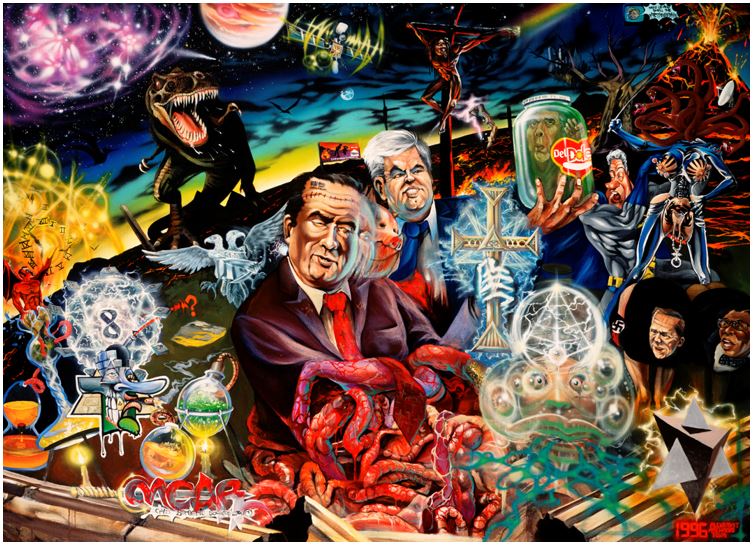It was recently revealed that Disney has decided not to renew Gina Carano’s contract, in part because of a pattern of posting “abhorrent and unacceptable” content ranging from unfounded claims of voter fraud to a comparison between the inciting of antisemitism by the Nazis and leftist incitement of hatred for conservatives in modern America. The last comment appears to have been the final straw, though it is likely that Disney was particularly concerned about escalating rhetoric from Carano on social media.
Amidst the debates of freedom and fairness, a frequent point of contention was a picture that Carano posted in December, which many have correctly identified as containing harmful tropes common in antisemitic conspiracy theories. Wherever I saw the image discussed, the same conversation always occured. There was always a response like “it doesn’t look antisemitic to me, how can you tell?” or “that picture is really just about wealthy elites”. Clearly all we need is just a refresher on how to spot antisemitic tropes, right?
This is where things get extremely messy. When I first pitched this article, I admit I had in mind a fairly straightforward story about crypto-antisemitic memes that hide their power level, and the role they play in on-ramping or red-pilling normies into the conspiracy theory ways of seeing the world. “Hiding one’s power level” is a frequently noted phenomenon where a conspiracy theorist masks their level of commitment and the extreme nature of their true beliefs to appeal to the unconverted. I figured I would just explain how memes like this bubble up from the far-right corners of the internet, but as I’ve discussed before we should be skeptical of simplistic narratives, and this is yet another example that I fell into personally. In order to explain, I’m going to show you a range of antisemitic content, some of which is extremely unpleasant, but we need to deal with this as openly as possible.
To make it more fun, I’ve made this article an interactive game, where you can first look at some dense memetic content and then click to reveal my detailed description to compare with your own experience. Maybe you’ll even catch somethings I missed! Let’s start with the image Carano posted:
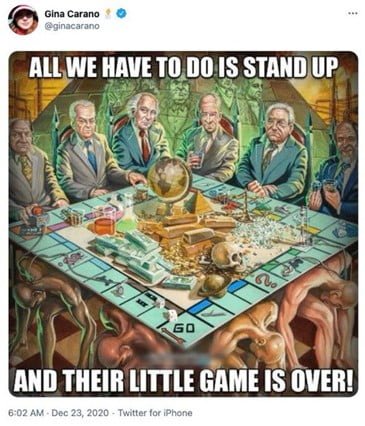
The image is part of a series called “False Profits” by an artist named Mear One (Kalen Ockerman). According to Mear, the series depicts a group of “fat, old, decrepit white men playing a game of Monopoly on the backs of the working class”. The version Carano shared appears to date back to 2016. UK readers may be getting hits of déjà vu to a story back in March of 2018, when the Guardian reported that Jeremy Corbyn had posted support for Mear One back in 2012 when a mural version of False Profits, entitled Freedom For Humanity, was criticized as antisemitic and painted over. Here is the 2012 mural version for comparison sake, because there are salient differences between them:
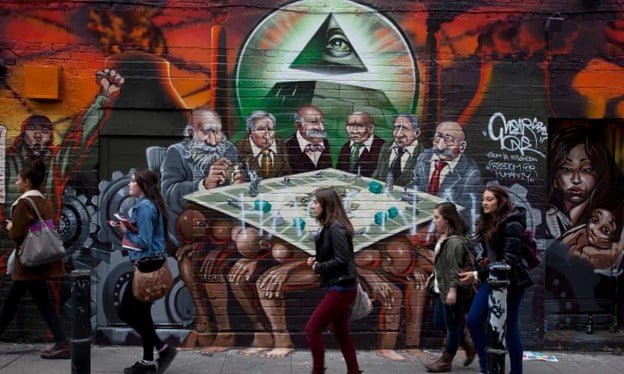
I want to note key differences between these images that strike me as relevant to assessing their antisemitic nature. Notice first the differences in the way the “bankers” are depicted. In the 2012 image, the individuals in power look far closer to classic Jewish caricatures:

In contrast, the “bankers” in the 2016 image are unlikely to register as “Jewish looking”, with the very notable exception of the individual on the far right holding the comically large diamond.

One final change that may be significant is that the “working class” individuals in the 2012 mural are all people of colour, while in the 2016 version they range from dark to light skinned.
With these differences made explicit, I could tell a plausible narrative about how the 2016 version takes the more overt antisemitism of the 2012 version and turns it into a dog whistle using more subtle symbolism. The antisemitism shifts from being clearly embodied in the characterisation of the individuals, and is instead encoded in the artifacts around them. Within that narrative, the change to the working class’s complexion could function to make the image more palatable to communities that might see themselves as the white guy under the table.
Mear One might respond that these changes were either simple variations on a theme or the artist incorporating criticisms of the 2012 version, albeit with limited success. I don’t think that we can necessarily infer artistic intent from these differences, as artists like Mear One do frequently produce series that vary in details.
However, it is fair to say that the 2016 version, while an improvement in some ways, is still discernibly antisemitic in its symbolism. There is just no need to have the Jewish looking “banker” holding a giant diamond, which are commonly associated with Jewish wealth because of a variety of historic reasons such as laws preventing Jews from owning land and, as my dad liked to say, because diamonds are easier to carry when fleeing from Cossacks.
To a less obvious extent, the addition of a button linked to a nuclear missile also signals to me the conspiracy theory that “Jews start all the wars” made famous by a drunk Mel Gibson. If the goal was to eliminate the antisemitism and not just make it more subtle, then Mear One failed as an artist.
What then are we to make of this art and individuals who share it? First, I want to confess, when I first saw the 2016 version shared by Carano, I just assumed it was coming from the same memetic ecosystem as this much more obviously antisemitic image I cited in my Monster Island article:
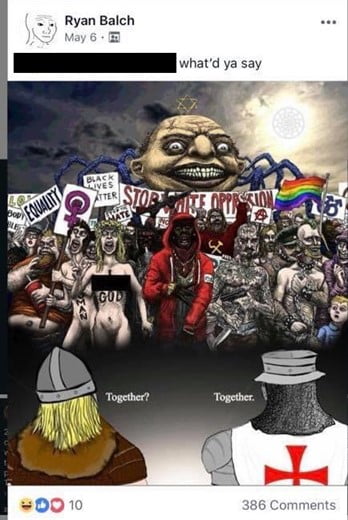
After researching Mear One, I’m not sure that’s accurate. The Monster Island meme is clearly coming from a reactionary conservative worldview, where the Jews are masterminding white genocide and the collapse of “Western Civilisation”. Conversely, Mear One appears to be coming from the opposite end of the political spectrum. His art is explicitly leftist in that it aims to critique “Western Civilisation” as a system of oppression run by the rich and powerful, some of whom look and are Jewish. While Mear One’s art is rife with conspiracy iconography, he vehemently denies any antisemitism. To get a sense of his art and the way that it taps explicitly into left wing conspiracy thinking centered around naturalism and liberation, consider his 2013 mural “Humanity vs. The Machine”:

Of course, Mear One’s art could be both leftist and antisemitic. I complicate the political narrative here because I think it’s easy, especially for folks like myself on the left, to see the image that Carano posted and just assume it was manufactured in a Nazi meme lab to suck in normies, perhaps with the goal to radicalise them when they’re canceled for antisemitism. I do not believe that is the goal of Mear One’s art, though I do think his art is easy for antisemitic communities to co-opt, because it does rely on antisemitic tropes.
A further complication is that Mear One’s work seems to draw on Hotep iconography, such as in his 2013 mural “The Awakening”:

Hotep ideology is an unfortunate mix of chauvinism, black supremacy, and conspiracy theories. The term is generally seen as derogatory, though some individuals do self identity as Hoteps. Hoteps sometimes share in the white supremacist conspiracy theory that Jews have used “true” people of color as foot soldiers in their culture war against the whites. Indeed, it is plausible to argue that Hotep involve a mix of both left-wing and right-wing black supremacy. This connection was made explicit in 2018 when Turning Points USA invited Bryan Sharpe as a guest at their retreat and praised his work explicitly. Sharpe, aka Hotep Jesus, is a black activist who has claimed “Jews want destruction of the black community” and has used (((echoes))) in the context of claims like “people in power is always (((them)))”.
Here is an interview Sharpe did with Young Pharaoh, another prominent Hotep who was just recently disinvited from the Conservative Political Action Conference because of antisemitic comments.
I can’t find any cases of Mear One explicitly self-identifying as Hotep, though much of the content on his site slots neatly into their mythology. I think it’s impossible to look at the picture above and not see a significant Hotep influence that goes beyond generic Afrofuturist themes. Here is a link to some similar Hotep art, because my editor will kill me if I add any more pictures to this article. Don’t worry though, if this is your first time ever hearing about Hoteps, I’m going to give them the deep dive they deserve in a future article.
None of this is sufficient to prove that Mear One is consciously being antisemitic with his art. It may just be another example of the Reverse Godwin, where conspiracy theorists will tend to converge on antisemitic memes because antisemitism is already ubiquitous in conspiracy discourse. Ultimately, I don’t know if Mear One is hiding his power level, and I don’t care if Mear One has antisemitism in his heart. What matters is that there is antisemitism in his art, both subtle and overt. If his goal is genuinely to criticise powerful individuals more broadly and not to keep getting sidetracked by accusations of antisemitism, he would benefit from listening to the concerns and adjusting his iconography.
As for Carano, I think it’s an understandable mistake for a normie to post the 2016 version of False Profits. However, forgiveness requires acknowledging the mistake and asking for forgiveness. John Cusack made a similar mistake in 2019 when he posted the following in what he claimed was solidarity with Palestine:

Cusack apologised profusely and acknowledged how the meme “deploys anti jewish stereotypes in its attack on Israel, even if those critiques about state violence are legit.” A similar situation occurred with Ilhan Omar, who also issued a substantial apology.
Compare their responses to Carano’s statement on the issue, made to Bari Weiss:
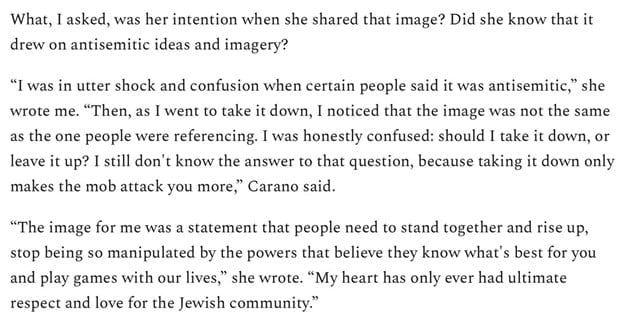
I think it’s fair to take Carano at her word that she didn’t know, and it’s worth noting that she correctly identified that the 2012 mural is more easily recognisable as antisemitic. Where I think Carano’s response goes astray is her belief that it could possibly be better in any sense to leave up either picture. Both images are antisemitic, and the idea that taking it down and apologising would result in worse mob attacks seems like a claim in need of evidence. I’m even more frustrated with Weiss’s response, as she appears to endorse Carano’s claim that taking the image down would be just as bad as leaving it up:

If the goal is to turn down the intensity on antisemitic conspiracy thinking, it seems like a bad idea to tell people that they will be hounded after as antisemitic even if they acknowledge their mistake and apologise. Weiss goes on to cite the Cusack example as proof that Carano is receiving unfair treatment as a conservative, while neglecting to mention that Cusack removed the image and apologised repeatedly, rather than equivocating on the antisemitic nature of image and playing the victim card. It is unfortunate that Weiss, author of How to Fight Anti-Semitism, is unable to provide more robust analysis here, possibly because of her own anti-woke biases. It should not be hard to help Carano understand the problems with the image and why she should acknowledge those problems and take it down, without having to break out the bothsiderism and the cancel culture talking points.
Instead, Weiss argues that cancel culture is bad because it erases intent, and Carano clearly didn’t mean to be antisemitic. Never mind that the same is likely also true for Cusack, Weiss is just wrong that intent is what really matters here. She falsely claims that intent is a crucial part of our legal system, when the reality is that the need to prove intent is more likely to be a requirement for crimes that are more likely to be committed by powerful individuals. The reason being that intent is extremely hard to prove. The effectiveness of demanding proof of intent as a shield for people in power was on full display during Trump’s first impeachment trial. What matters here are Carano’s choices after having the mistake pointed out, which could have been better. Sadly, I suspect she wasn’t getting the best advice on these issues. At least Weiss proves her own point about unrelenting criticism, since Cusack taking down his post and apologising did not cause her to soften her criticism of him.
Beyond these images is a larger question about whether it’s possible to criticise “bankers”, or “globalists”, or Israel, or specific wealthy Jewish individuals like George Soros without it being antisemitic or perceived as antisemitic. I think the answer is yes, but the path there is socially fraught, and I can understand why many just avoid the topic entirely rather than risk causing offense. I’ve spun out way too much red yarn at this point to give a full account of how to avoid these mistakes. My main suggestions are to avoid material that plays to stereotypes of Jewish individuals or institutions as all powerful puppet masters. Avoid anything that gives the impression of Jews being unique in either their means (extra cunning, own all the banks/money) or their ends (great replacement/reset conspiracy theories). Learn more about common antisemitic tropes, but also try to be sympathetic to those who don’t have hours to devote to these very depressing rabbit holes. After all, here’s one more of Mear One’s pieces, titled Heavens to Mergatroid, that I could absolutely imagine me and my lefty friends sharing around without noticing the misogyny.
